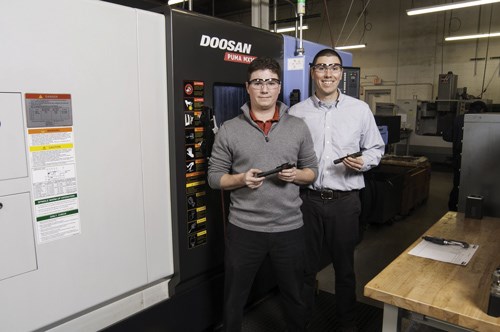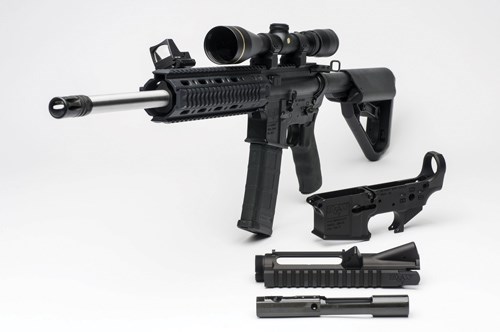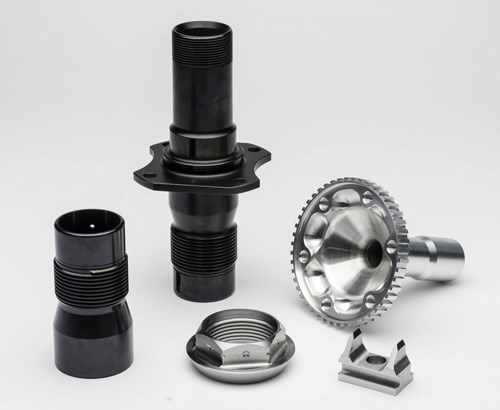Multitasking Helps Detroit Shop
Brothers Arnot and Matt Heller are 30-something, degreed engineers running Central Screw Products and Detroit Gun Works. They are also fourth generation, hands-on machinists and know a thing or two about machine tools, automation and the critical role of new technology in business growth.
Detroit Gun Works (DGW) currently employs a small select team of engineers and machinists in a 15,000 square-foot facility in Troy, Mich., with cutting edge machine tools — including a Doosan MV 5025/50 four-axis VMC equipped with automated part loading and robotic part handling and a Doosan Puma MX 1600 ST multitasking turning center with nine full axes, left and right main spindles, a B axis with virtual Y axis, a lower turret and an FMB Turbo 5-55 bar feeder.
They are a small business, yes, but arguably well equipped—and all ensconced in an ISO 9001 certified environment, which will soon be AS9100 certified.
Common materials machined by the shop include aluminum, carbon steel, stainless and tool steel. Its major markets served are heavy truck—in particular, suspension components—firearms and auto racing. Tolerances are typically 0.001 inch to 0.0002 inch when hard turning.
Determined to Make Chips
Great grandfather and grandfather Heller came to Detroit during the Great Depression. Right after the war, the two of them decided to start AB Heller Screw Products, which was to be a short-run prototype business. However, they couldn’t buy machine tools at the time because of the war rationing.
One of them had a relationship with Hardinge, and not to be put off by the war rationing, the two elder Hellers decided to buy spare parts out of the Hardinge catalog
and assemble their own lathe and chucker, which they did. The two machines went into a basement, and that’s how they started AB Heller Screw Products.
CSP Begets DGW
In 1975, Arnot and Matt’s father bought Central Screw Products (CSP) with the help of their father. Initially, their CSP was an Acme Gridley house doing heavy truck work and agriculture work. Under Arnot B. Heller II, CSP ran low volume production screw machine work. Then the boys gradually moved into production machining. “That was one of our problems,” Arnot says. “Your customers tend to put you into a box, and they like to keep you there. They come to associate your name with certain types of parts and capabilities — whether you’ve outgrown those capabilities or not.” When Arnot and Matt took over, they wanted to pursue CNCs and robots.
Arnot Heller went to work for his father in 1999, and
they were doing work for a well known major tool manufacturer making mechanics’ hand tools, roughly a $5 million account, running all the components in-house. Then, in June 2001, the tool company called and said,
“You guys don’t need to do that anymore.” The tool company had decided to make the components offshore. So in the time it took for one short phone call, CSP went from a $6 million company to a $1 million company.
However, the Heller family believed there was a place for them to make complex, challenging parts domestically by getting into multi-axis milling and turning. More than that, they needed to take the step to automation to maximize cost efficiencies.
“And this is what we faced with the launch of Detroit Gun Works (DGW),” Arnot says.
Boom in Firearms
“In 2008 and 2009, the firearms market was booming,”
Arnot says. “My brother Matt and I started thinking about this expanding market, and we knew that people who like guns, like to know how they’re made, where they’re made, of what they’re made. They want to know exactly where the parts for any given gun are manufactured and assembled. Also, customers in this industry want a firearm that will
fire 100,000 rounds and at the same time look like a highly polished, precision piece of jewelry.
“Further, we understood that to manufacture for the firearms industry, you have to have special permits to make serialized gun receivers, and the Chinese couldn’t get these permits. So right there we’re looking at a product that has to be made domestically. I’ve also felt that if you want to run high-value machine tools and make very cool things, all roads sort of end up leading to aerospace and military.”
Starting out, DGW sold to Tier-Three firearms builders. These builders would supply police departments, hunting/shooting enthusiasts and small military outfits. “The model here is pretty simple,” Arnot says. “You have component manufacturers, assemblers, distributors and customers. In the past, gun manufacturers were much more vertically integrated, in that, they would manufacture, assemble and distribute all under one name and all in one place.”
AR-15 Changes Things
Today, DGW has a core competency in components for the AR-15 and .308 caliber semi-automatic rifles, particularly machining the frames for the upper and lower receivers. These are lightweight forged aluminum parts and are run in a special robotic cell. Another strong competency area lies in bolt carriers, made of 8620, that run on the Puma multitasking mill-turn center.
The way the Puma MX purchase came about was like this: Arnot and Matt were at IMTS 2012 looking for a machine with flexibility and versatility to run a number of difficult parts and expand their capabilities. They were looking at multitasking brands and came across the Doosan Puma MX. “We bought the machine because I’d always wanted a machine like the Puma MX. It’s like a machine shop in a box, with the combination of two lathes and a mill with a B axis and an automatic feeder on it.” Arnot says. “And Matt said you can buy the machine providing you can find a part to run on it. The AR-15 bolt carrier was the perfect candidate.
“Plus, we looked at the success we’d had with our Doosan VMC, which runs 20 hours a day every day of the year,” he says. They bought the Doosan Puma MX right off the show floor.
Performing Under Pressure
Arnot says, “The Puma MX allows us to perform under pressure—running bolt carrier parts one day and motorsports parts the next. The machine is extremely versatile. We ‘spec’d’ out the Puma MX as the perfect machine to manufacture the bolt carrier. The reason is that it’s an 8620 part, and we needed lots of horsepower and rigidity to hold tight tolerances on the OD that runs back and forth in the upper receiver, as well as holding the concentricity and tolerance requirements on the ID. In addition, there are some pretty significant milling features on the part.”
DGW uses more than 100 percent of the torque and the full 12,000 rpm on the B axis to mill flats on the back and front sides, as well as using four-axis capability to do cam slots. The machine also offers high pressure coolant through the B axis, which allows the shop to get incredible tool life in the small holes where the part is drilled in. “So, not only do we use the left spindle, but we also pass the part off to the right spindle to get the part in a single hold, and use the upper and lower turrets to do simultaneous multitasking machining to get our cycle time as low as possible to make this component,” Arnot says.
In addition, these parts require hard turning on the ID of the three diameters on the one end to allow the bolt to ride correctly back and forth, and the Puma MX is rigid enough to allow DGW to do the hard turning while simultaneously running the other primary operations.
Matt adds, “A lot of our competitors are running components with relational tolerances from the milling operations to the turning operations. Being able to do that in a single platform by passing the part from the left spindle to the right spindle and having the capability to mill in either turret via the B axis, we’re able to maintain our tolerances and are capable of doing more challenging parts than we were able to do in the past.”
Expectations and New Directions
Adding multitasking capability is a good example of how DGW has changed over the last year or so. It’s a technical piece of equipment that requires skilled labor to run it in the form of people who can visualize how to run a part. On this particular machine, there can be 100 different ways to run the same part because of the machine’s versatility, so the trick is how to optimize that kind of flexibility and versatility. Success is not just looking at how fast a part can run, but rather, running it right and for long periods of time. With the bar feeder, 20 bars, 2 inches by 12 feet can be loaded, and run for days, if volumes justify it. Tool life becomes an issue on long run jobs. To assist, the machine uses a tool monitoring system that automatically checks for worn or damaged tools as well as the presence or absence of tools.
“This is really a highly technical gateway machine, in that it can open avenues to many other industries and applications and consequently many other types of customers,” Arnot says. “The reason we purchased this piece of equipment was because this is where we see the direction of our company going, in terms of value added services, engineering, design for manufacturing, and making components that other people cannot make.”
Matt is primarily focused on sales, and Arnot has been more focused on the day-to-day operations side of the business. They recently brought on a seasoned firearms industry engineer and business development executive with more than 2 decades of experience to help them grow the DGW brand. But over time, they aspire to hire people to work with Matt on the sales side as well as people to work with Arnot on the operations side. The types of employees they hope to attract will want to run new, exciting, complex machine tools such as the Puma MX. “These people are essential to our growth and long term success,” Arnot says. “It’s a growth pattern that we see evolving over time.”
DGW is now running two shifts a day, and because of automation, they run the machines untended during what would be a third shift, which is great machine utilization. Arnot says the company couldn’t achieve this without a machine capable of performing under the pressure of his customers’ demands.
He says, “The emphasis for both companies will continue to center around building new core competencies with a focus on using best practices in lean manufacturing, sophisticated cutting edge technologies, robotics and automation. These are our core beliefs, and we believe this is how we can best serve our customers cost containment and quality needs.”
Yes, it should be absolutely clear that the Heller brothers have both chips and cutting fluid in their veins.
Related Content
Does a Scanning Probe Make Sense on a Swiss-Type?
Swiss-types have limited tooling capacity, but there can be advantages to giving up some of that capacity to take advantage of a touch probe — in fact, a scanning probe — to enable in-process part measurements.
Read MoreChoosing the Right Machine for Turned and Milled Medical Parts
The medical market is known for exceptionally tight tolerances and difficult materials, which means that selecting the proper machine is necessary to ensure a job is profitable.
Read MoreCAM-Driven Lathe Questions
There can be hidden issues using legacy cam-driven lathes that can be overcome using new CNC technology. Here are three to keep in mind.
Read MoreSoftware Controls Chip Breaking in Thread Turning Operations
This cutting tool manufacturer has developed a software module for chip control of thread turning operations in virtually any CNC lathe, even for older machines, using specific tooling and software.
Read MoreRead Next
Turn-Mill Machines Turn a Shop's Situation Around
It often takes seeing a machine in action to conjure up a solution to a shop’s problem. This was the case for Steve Walters, an engineer at TriContinent Scientific Inc.
Read MoreEmerging Leaders Nominations Now Open
Here’s your chance to highlight a young person in your manufacturing business who is on the path to be a future leader moving your company forward.
Read More5 Aspects of PMTS I Appreciate
The three-day edition of the 2025 Precision Machining Technology Show kicks off at the start of April. I’ll be there, and here are some reasons why.
Read More











.jpg;maxWidth=300;quality=90)













